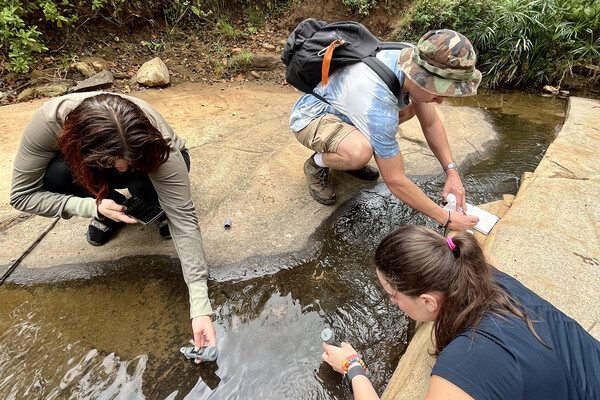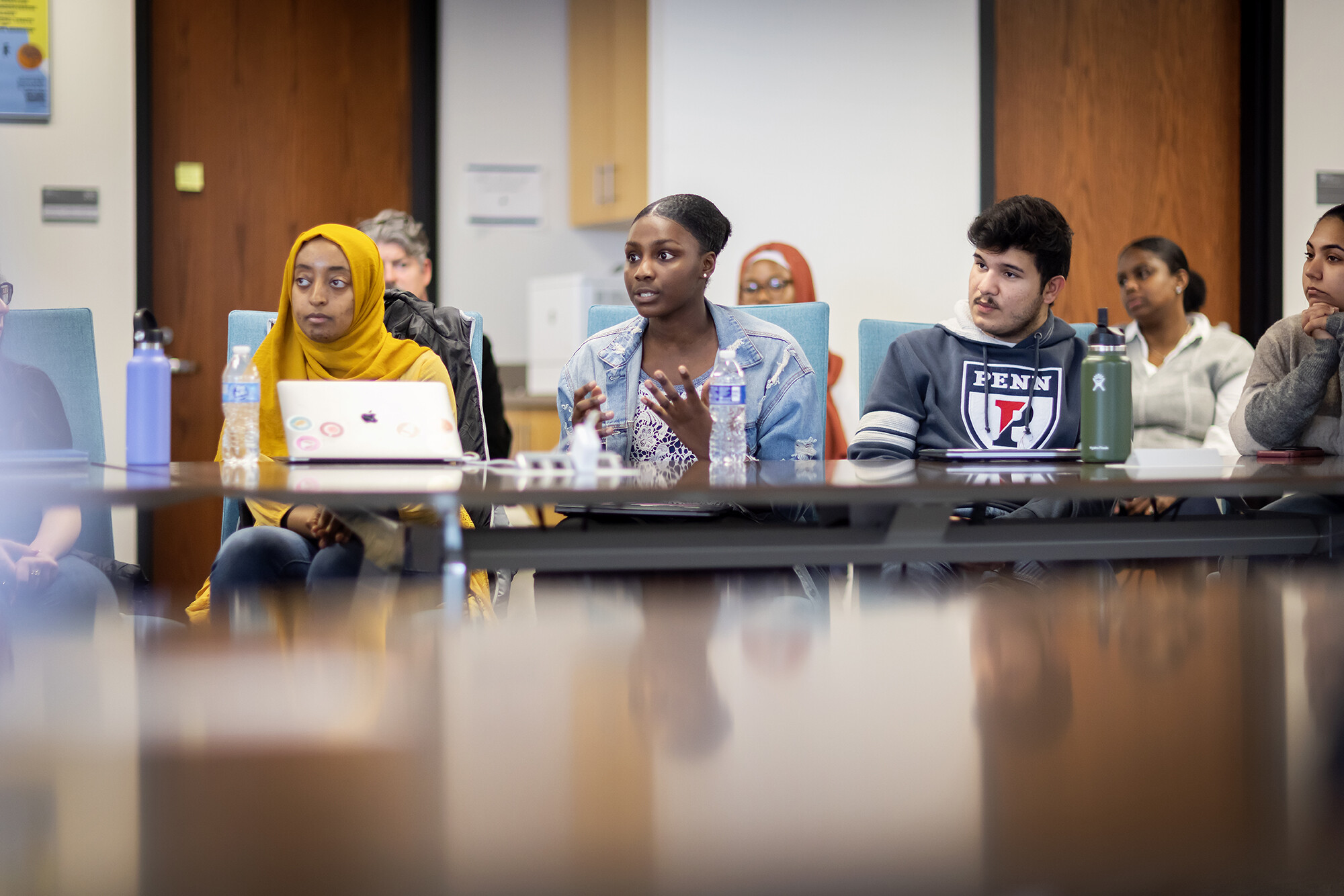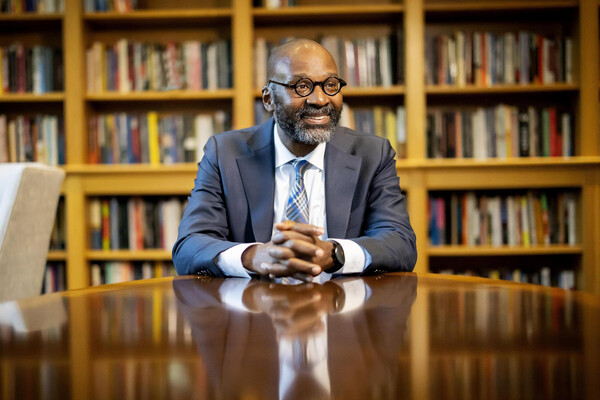
Griffin Pitt, right, works with two other student researchers to test the conductivity, total dissolved solids, salinity, and temperature of water below a sand dam in Kenya.
(Image: Courtesy of Griffin Pitt)

How do you define death? What steps can help overcome vaccine hesitancy? Why are genetically modified foods so controversial? And let’s not even talk about climate change.
Actually, let’s talk about it.
A course in the School of Arts & Sciences’ Department of Biology, taught for the first time this spring, has not shied away from wading into these difficult topics and many more, including racism, sexism, creationism, and eugenics. Biology and Society, co-taught by professors Mecky Pohlschröder and Paul Schmidt, with assistance from teaching assistant Lorianna Colon, a postdoctoral fellow at Children’s Hospital of Philadelphia, was designed specifically to create a space for such societal issues within a STEM department.
“We wanted an open discussion forum for these issues, broadly defined, that connect biology and society,” says Schmidt. “We became aware that, although there are courses like this taught outside STEM departments, there are few taught within STEM. We wanted to center something in the biology first, letting the scientific information be the foundation, and then get into the societal impact.”
For Pohlschröder, the roots of the course trace back to before her tenure at Penn. “My postdoc advisor, Jon Beckwith, taught a course like this at Harvard Medical School for over 20 years,” she says. When Beckwith retired, he hoped to see the course continue, and Pohlschröder was among those who took up the charge. The Stavros Niarchos Foundation (SNF) Paideia Program at Penn supported the effort, which aligns with the program’s emphasis on promoting civil discourse and providing a holistic education.
Earlier this semester the biology faculty voted on whether to integrate the course as a department elective, and there was unanimous support.
“The emergence of this course was very organic,” says Junhyong Kim, the Patricia M. Williams Term Professor and Chair of the Department of Biology. “During the past several curricular sessions and faculty retreats we’ve had, we have thought about the need to incorporate into our curriculum more material that addresses biology and society: both how society affects what we do, and the need for scientists to be aware of the social implications of what we study and what we say.”
As a tribute to Beckwith’s influence, the syllabus instructed students to begin the course by watching a video of him speaking about his entry into activism. Each subsequent class introduced different featured speakers, which included not just Pohlschröder, Schmidt, and Colon, but several others from the biology department and elsewhere at Penn. Among them, marine biologist Katie Barott presented on climate change, geneticist and anthropologist Sarah Tishkoff led a class discussion on genetics and race, historian of science Beans Velocci spoke on sexism and gender, and neuroscientist Martha Farah headed up a class meeting on neurobiology and society. In one session, postdocs Colon and geneticist Patricka Williams-Simon used the story of Henrietta Lacks to provide the focus for a talk on the intersection of genetics, race, and ethics,
“One important thing is that the presentations by faculty member are fairly short, so for something like CRISPR gene editing, we learned how it works from Andrew Santiago-Frangos, who will join the biology department faculty this coming January,” Pohlschröder says. “But then the rest of the class session was devoted to, what are the implications?”
Before the course began, the instructors wondered whether students would sustain discussion for two or more hours. Kayla Davis, a teaching assistant in Beckwith’s class who provided guidance during the development of the course, assured them it wouldn’t be a problem. And her predictions played out, with rich discussions filling the allotted time each week.
“One theme that has come though all these class meetings, even though the topics are so extremely different, are education and communication,” says Pohlschröder. “Those are the main solutions, and that speaks to the whole SNF Paideia model: How do you have dialogue between a scientist and a non-scientist? So many things could be resolved if we as scientists can communicate more effectively.”
Despite their variety, the assigned topics only skimmed the surface of the areas of interest for the students. In one of their last meetings, the students formed groups and researched other topics that piqued their interest.
As sun streamed in the windows of a classroom on the second floor of Goddard Laboratories one Tuesday afternoon, a student group led an exploration of how artificial intelligence has already affected mental health care, and how it may continue to evolve the field. They noted the benefits—easier accessibility to care and possible cost savings—as well as potential drawbacks—liability and a lack of personal connection among them.
Another group explored vaccine hesitancy, while a third probed the question of how to define death, raising mind-bending ethical questions about, for example, keeping a pregnant person on life support to save the life of an unborn child, or an independent hospital considering a patient who is brain-dead to be dead, while a Catholic hospital does not.
In the final class, they received a visit from Ala Stanford, regional director of the U.S. Department of Health and Human Services. She is perhaps best known in the Philadelphia area for her leadership of the Black Doctors COVID-19 Consortium, an organization credited with testing and vaccinating thousands of people against the SARS-CoV-2 coronavirus, focusing on underserved, low-income communities, and shifting the paradigm for medical care delivery.
“What does every community need to thrive?” Stanford queried the room at the start of her visit. “You need good schools, you need good hospitals, you need strong financial institutions, and you need grocery stores.” Stanford proceeded to explain that many neighborhoods comprised primarily of Black and brown residents lack these foundational institutions, due to such practices as redlining, as well as other types of systemic institutional racism, thus hindering their residents’ ability to prosper.
Such factors contribute to the social determinants of health, explained Stanford, who is a pediatric surgeon. “I expect many of you will go on to be doctors, too,” she said. “When you’re wondering why your patient may not be doing well after surgery, very often it’s not their biology, it has to do with social determinants of health.”
Stanford told the class that her upbringing in a Black community in North Philadelphia equipped her with an understanding that many narratives widely accepted by the medical community are not supported by the facts. During the pandemic, for example, she often heard colleagues say that Black people did not want to be vaccinated. “But that may depend on who is giving the vaccine,” she said. (Later, she showed a video of patients—including many people of color—in a seemingly endless queue to receive the COVID shot at the primary clinic she opened during the pandemic in North Philadelphia.)
Responding to student questions, such as, “How do you gain trust if you don’t look like your patients?” Stanford explained that trust can be earned, biases addressed—and education can help.
“Black women represent 43% of the births in Philadelphia, but 73% of the deaths,” she noted. “Every time I see a disparity that’s so vast, it always goes back to education and those social determinants of health that got us here in the first place. You have an obligation to make sure what you’re learning is accurate.”
Following her private talk with the class, she walked with the students to Tedori auditorium in the Levin building to give a public lecture, where she advised the audience to seek to reduce health disparities. “Everyone plays a role in health equity,” she said. “I’m a surgeon and wound up doing primary care in a parking lot. Maybe you’re a student helping others get medical care. Maybe you can make sure children get the vaccines they need. Identify your role.”
At the close of Stanford’s talk, second-year student Yasmeen Haruna presented her with a Certificate of Appreciation from Steven Fluharty, dean of the School of Arts & Sciences, commending her “continued commitment to higher education and health equity” and for serving as “a role model for the next generation of scientists and physicians that we are educating here at the University of Pennsylvania.”
Stanford’s talk was a fitting culmination of the course for Haruna, a biology major from East Orange, New Jersey, who says she “can’t stop raving about it” to her friends and peers.
“Dr. Stanford’s presentation was honestly—and I don’t want this to sound exaggerated—but it was kind of life-changing for me,” says Haruna, who is also part of the PennFERBS (Freshman Exposure to Research in the Biological Sciences) program run by Pohlschröder. “This course has been an outlier in all my STEM courses, because I’ve truly been able to use what I’ve been learning in my hard science classes and combine it in my day-to-day life and what it means to be a Black woman in STEM.”
That came into play, for example, during a discussion of vaccine hesitancy, part of a student-led presentation at one of the last class meetings.
“We spoke about vaccine hesitancy, especially within a lot of communities of color, and talked about why that is the case,” Haruna says. “I’ve definitely seen how that’s played out in my family and my community. Especially as someone who wants to work in health care and foster relationships with my future patients, it’s important to try to understand that context.”
During class meetings, the undergraduates weren’t the only ones learning. “I definitely feel like I’ve learned a lot,“ Pohlschröder says. “And sometimes what’s also really great is that students will come back to class and say they’ve discussed this or that subject from class with their roommates. It goes beyond the class.”
“You can see people changing their opinions on questions as we’re discussing them,” adds Schmidt. Colon agrees. “The students bring so much to the class,” Colon says. “A student will make a comment or bring up a point that might deviate from what’s being presented and get the whole room to think differently or consider a new point of view.”
As the course wrapped up, the biology department is enthusiastic about keeping its probing discussions and examinations going.
“When people leave here with a Penn diploma, we want to make sure that they know they won’t be doing science in a vacuum,” says Schmidt.
“In our first class,” adds Pohlschröder, “we discussed what the students thought a scientist’s responsibility is. We as scientists, if we develop some new discovery into a new tool or product that we think is really cool, we can’t stop there. We have to think about the overall impact that contribution might ultimately have on the world.”
Katherine Unger Baillie

Griffin Pitt, right, works with two other student researchers to test the conductivity, total dissolved solids, salinity, and temperature of water below a sand dam in Kenya.
(Image: Courtesy of Griffin Pitt)

Image: Andriy Onufriyenko via Getty Images

nocred

Provost John L. Jackson Jr.
nocred